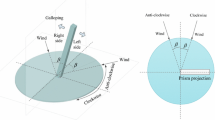Abstract
The aerodynamic behaviour of prismatic bodies in a wide range of angles of attack is addressed in the present work. In particular, we focus on bodies with a basically rectangular shape, either sharp or cylindrical edges and different thicknesses. In general, the thinnest bodies exhibit the largest lift-to-drag ratio at moderate angles of attack, which is further enhanced with rounded edges. At larger angles of attack, bodies with rounded edges exhibit smaller drag than bodies with sharp edges. Roughness was found to enhance the lift-to-drag ratio significantly at small angles, and drag is reduced at larger angles.













Similar content being viewed by others
Abbreviations
- A :
-
Cross-sectional area
- b :
-
Span width
- c D :
-
Drag coefficient
- c D,r :
-
Recalculated drag coefficient applying a different reference area
- c L :
-
Lift coefficient
- c L,r :
-
Recalculated lift coefficient applying a different reference area
- c M :
-
Pitching moment coefficient
- D :
-
Drag area
- F D :
-
Drag force
- F L :
-
Lift force
- H :
-
Height
- L :
-
Lift area
- l :
-
Reference length
- M :
-
Pitching moment
- q :
-
Dynamic pressure
- Re :
-
Reynolds number
- Re Cx :
-
Critical Reynolds numbers
- T :
-
Thickness
- t :
-
Time
- v :
-
Velocity
- W :
-
Width
- α :
-
Angle of attack
- β, γ, δ:
-
Angles characterising posture and position of ski jumpers
- ρ :
-
Fluid density
- Λ:
-
Aspect ratio
- ν:
-
kinematic viscosity
References
Achenbach E (1971) Influence of surface roughness on the cross-flow around a circular cylinder. J Fluid Mech 46:321–335
Achenbach E, Heinecke E (1980) On vortex shedding from smooth and rough cylinders in the range of Reynolds numbers 6×103 to 5×106. J Fluid Mech 109:239–251
Anderson JD Jr (1991) Fundamentals of aerodynamics. McGraw-Hill, New York
Barlow JB, Rae WH Jr, Pope A (1999) Low-speed wind tunnel testing. Wiley, New York
Bearman PW (1969) On vortex shedding from a circular cylinder in the critical Reynolds number regime. J Fluid Mech 37:577–585
Fage A, Johansen FC (1927) On the flow of air behind an inclined flat plate of infinite span. P Roy Soc Lon A 113:170–197
Flachsbart O (1932) Messungen an ebenen und gewölbten Platten. In: Ergebnisse der Aerodynamischen Versuchsanstalt zu Göttingen 4:96–100
Gretler W, Meile W (1991) Eine Sechs-Komponenten-Plattform-Windkanalwaage. ÖIAZ 136/9:403–408
Gretler W, Meile W (1993) Der 2m-Windkanal am Institut für Strömungslehre und Gasdynamik der Technischen Universität Graz. ÖIAZ 138/3:90–96
Hanna RK (1996) Going faster, higher and longer in sports with CFD. In: Haake S (ed) The engineering of sport. Balkema, Rotterdam, pp 3–10
Hu BK, Stollery JL (1990) The performance of 60° delta wings: the effects of leading edge radius on vortex flaps and the wing. Report no 9004, College of Aeronautics, Cranfield, England
Hucho WH (2002) Aerodynamik der stumpfen Körper, Vieweg, Braunschweig/Wiesbaden
Müller W, Platzer D, Schmölzer B (1995) Scientific approach to ski safety. Nature 375:455
Müller W, Platzer D, Schmölzer B (1996) Dynamics of human flight on skis: improvements on safety and fairness in ski jumping. J Biomech 29(8):1061–1068
Müller W, Schmölzer B (2002) Computer simulated ski jumping: the tightrope walk to high performance. In: Proceedings of the 4th world congress on biomechanics, Calgary, Canada, August 2002
Müller W, Gröschl W, Schmölzer B, Sudi K (2003) Body weight and performance in ski jumping: the low weight problem and a possible way to solve it. In: Proceedings of the 7th IOC world congress on sport sciences, Athens, Greece, October 2003, 43D
Panchenko IN (1999) Investigation and calibration of aerodynamic balances. Central Aerohydrodynamic Institut Tsagi, Zhukovsky
Remizov LP (1984) Biomechanics of optimal flight in ski jumping. J Biomech 17:167–171
Schewe G (1983) On the force fluctuations acting on a circular cylinder in crossflow from subcritical up to transcritical Reynolds numbers. J Fluid Mech 133:265–285
Schewe G (1986) Sensitivity of transition phenomena to small perturbations in flow round a circular cylinder. J Fluid Mech 172:33–46
Schlichting H, Truckenbrodt E (1969) Aerodynamik des Flugzeuges, vol 2. Springer, Berlin Heidelberg, New York
Schmölzer B, Müller W (2002) The importance of being light: aerodynamic forces and weight in ski jumping. J Biomech 35:1059–1069
Schmölzer B, Müller W (2004) Individual flight styles in ski jumping: results obtained during Olympic games competitions. J Biomech (accepted for publication)
Stromberg A, Henze A, Limberg W, Krause E (1996) Investigation of vortex structures on delta wings. Z Flugwiss Weltraum 20:71–79
Acknowledgements
The authors gratefully acknowledge support from the Austrian Research Funds (FWF, P14388-TEC), the International Olympic Commission (IOC) and the International Ski Federation (FIS).
Author information
Authors and Affiliations
Corresponding author
Rights and permissions
About this article
Cite this article
Reisenberger, E., Meile, W., Brenn, G. et al. Aerodynamic behaviour of prismatic bodies with sharp and rounded edges. Exp Fluids 37, 547–558 (2004). https://doi.org/10.1007/s00348-004-0840-0
Received:
Accepted:
Published:
Issue Date:
DOI: https://doi.org/10.1007/s00348-004-0840-0



